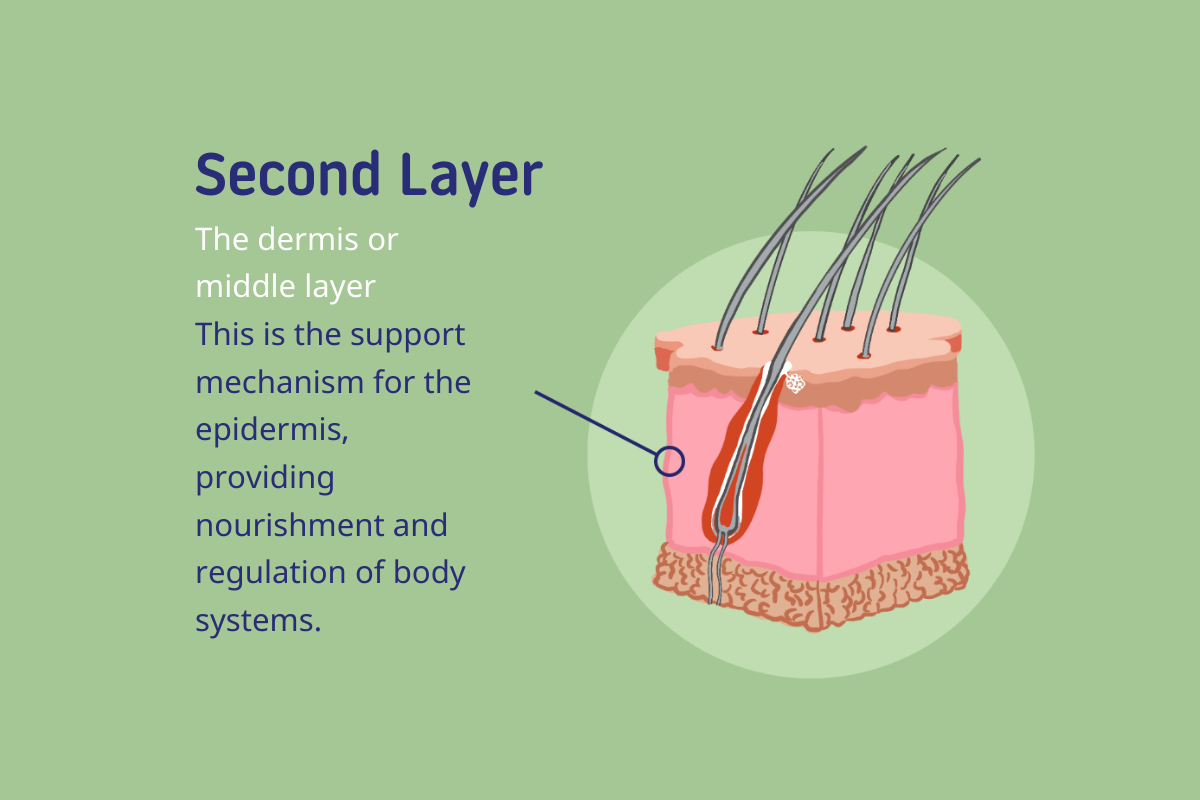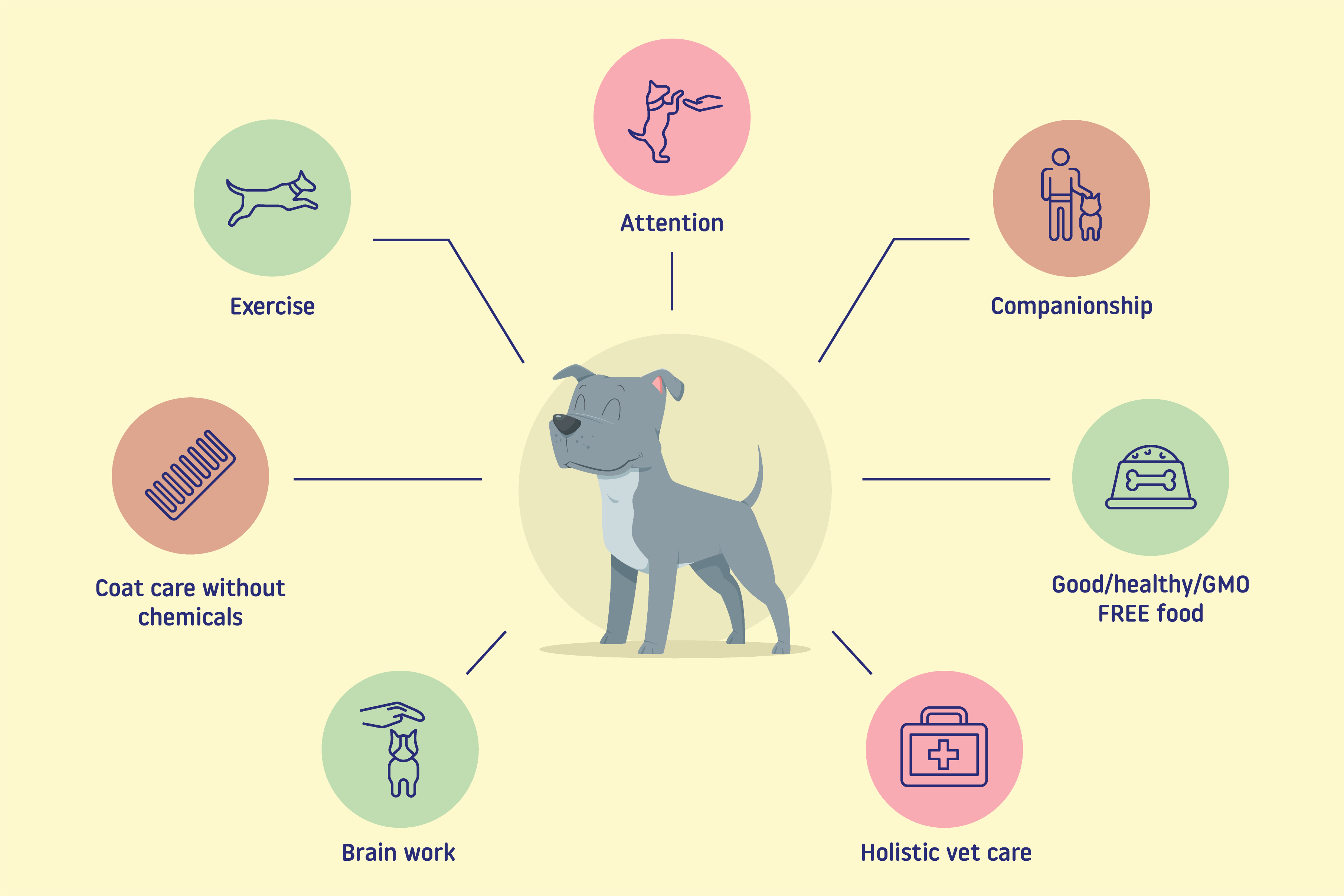The Wonders of Dog's Skin and Coat, Layer by Layer
We all love to see our lovely pooches with shiny glossy coats, but where does this coat originate from? The skin of course – the largest organ in the body!

Epidermis – the outermost layer of skin
- Keratinocytes, which create a protective layer that keeps in fluids, salts, and nutrients while keeping out infectious or noxious agents.
- Melanocytes, which produce a skin and hair colouring called melanin.
- Langerhans cells, part of the immune system which play an essential role in the skin's response to foreign substances.
- Merkel cells, which provide animals with sensory information.

Dermis – the middle layer
- Blood vessels in the dermis supply nutrients and regulate skin and body temperature.
- The dermis contains immune cells to defend against infectious agents that pass through the epidermis.
- Sensory and motor nerves in the dermis detect and respond to threats such as pain or heat.
- The dermis secretes collagen, a protein that supports the skin.

Subcutis – the innermost layer
Consisting of subcutaneous fat and muscles, the subcutis has many functions:
- Insulation to conserve body heat.
- A reservoir for fluids, electrolytes and energy.
- The muscular layer gives the skin the capacity to twitch.

So, where does the hair come into this whole system?
Well, the structures from which hair grows comes under a group of structures known as skin appendages.
Your dog's skin will contain the following skin appendages:
- Hair follicles;
- Nails;
- Sebaceous glands, which secrete an oily substance called sebum onto thehair follicles and skin;
- Sweat glands, usually only found in the pads of the feet of dogs;
- Mammary glands.
So, as we're all here because we want to care for our dog's coats in the best possible way, let's take a deeper look at these hair follicles!
The hair follicle originates in the dermis and continues up through the epidermis. Nourishment for the hair follicle is provided via the subcutaneous layer. The base of the hair follicle is a bulb-shaped structure, which narrows as it extends up through the skin's surface. Dogs have what is known as a compound hair follicle – this means that they produce multiple hairs with different functions. Each strand will grow central guard hair; this usually is quite long, thick, and wiry. This hair creates the top layer of the dog's coat. In addition, the guard hair will be surrounded by three to fifteen shorter hairs which create the undercoat.
Because the size, shape, and length of your dog's hair are controlled by genetics, different breeds will have different coat characteristics. For example, some breeds, such as poodles and wire-haired tarriers, have plentiful guard hairs but fewer under-hairs. Other breeds, including shepherds and rottweilers, have fewer follicles but have more hairs sprouting from each strand.
The genetics of the dog also affects the rate at which hair will grow and fall out. Some breedsshed their coats seasonally and will grow a different coat in the summer months compared tothe winter. Others shed lightly all year round, with no seasonal difference in the coat. Other breeds, such as poodles, will barely shed their coats at all but have to be regularly scissored.

DIFFERENT DOG COAT TYPES
Understanding your dogs coat type will help you when it comes to grooming and knowing what products are best to use.
So, now we know the basic anatomy and physiology of skin and hair, we need to figure out how to keep these essential structures healthy. As we've already discussed, nourishment for the base of the hair follicle comes from the subcutaneous layer of the skin. But where does sebum come into it.
Sebaceous glands are normally located at the base of or near each hair follicle, on the surface layer of the skin. These secrete sebum, which will penetrate the hair follicles as well as coating the surface of the skin. The importance of sebum to a healthy coat should never be underestimated!
We have been led to believe for years that oil is a bad thing when it comes to healthy hair and skin. While an excess of oily sebum can cause problems, some sebum must be present on the skin to maintain healthy skin and coat. Sebum is a mixture of fatty acids and makes the coat sleek and shiny whilst keeping the skin pliable, soft and moist.
The condition of a dog's coat is often a good indicator of the dog's overall health. Many external factors affect the health and appearance of the skin and coat, including hormones, disease, parasites, medication, environment, and nutrition. A healthy coat will be smooth and shiny and free from greasiness or dandruff. The skin itself should be clear and supple, free from grease, flakes, or bumps.
And what about the hair itself – how can we tell that it is healthy? If you're new to the world of natural pet coat care products, you might be uncovering a whole world of issues you never knew existed, as chemical-laden products will hide damaged hair rather than repairing it. Signs that your dog's coat is damaged include the following:
- The texture of the coat may be dry, coarse, and brittle;
- The hairs may break easily when groomed;
- The coat will appear less sleek and shiny and may look dull and matted;
- The colour of the coat may fade;
- You may find yourself applying multiple products to give a sleek and healthy look to the coat and hair.
So why do so many dogs suffer from unhealthy coats and skin? This is a massive topic in itself, but we'll take a quick look at the root cause of the problem! If your dog is in poor health or not receiving the nutrition it needs, the body systems will prioritise what it considers to be vital organs, such as the cardiovascular and gastrointestinal systems. Unfortunately, the skin comes relatively low down on the list when it comes to dishing out nutrients, so it is usually the first organ to show signs of damage.
Often, we don't realise that our dog's skin is in poor condition until it is too late, and the damage to the hair has already been done. What usually happens is we see something we don't like the look of, such as dry hair, or greasy skin. We then pop to the pet shop and look for a product that will 'fix' this problem – except this will not usually repair the problem but simply mask it. We also often forget to look at other factors which might make the skin unhealthy, such as environmental contamination or poor nutrition.

7 Tips to Make your Dog’s Life Happy & Healthy
So, what is the solution?
Here at Doglyness we passionately believe that a holistic approach is the only way to create a truly healthy coat. We must nourish the skin from the inside out and protect the skin from environmental nasties and toxic products. And when we reach for coat care products, we should be looking for something which will repair the damage and nourish the skin, rather than a quick fix to hide the problem.
We want to finish with one example of how this works. Let's imagine that your dog has dull, matted hair that breaks easily when groomed. You will find lots of different deep conditioning products in the pet store, all claiming to be the miracle solution to this problem. These will likely contain silicones – chemical compounds that add slip and silky texture to hair. The problem with silicones is that they accumulate on skin and hair follicles, blocking pores and making the skin itself dry and dull.
Basically, you are buying an illusion – the coat will look and feel better, but to the overall detriment of the health of the skin and hair! This is how most commercial products work – the hair is stripped bare with a harsh shampoo, and then an artificial conditioner is used to trick us into thinking the hair is healthy. Take away these products and you will reveal hair that is dull, dry, brittle, and damaged.
We swap to natural conditioning agents, such as the colloidal oatmeal in our OATS Calming Line or anti-aging Immortelle, Phyto proteins, and Phytosterols in our IMMORTELLE Rejuvenating Line, we don't hide the problem – we fix it. Colloidal oatmeal is the ultimate natural ingredient to help repair and protect damaged skin, leaving your dog itch-free, smooth, shiny, and soft. In addition, a combination of anti-aging Immortelle, Phyto proteins, and Phytosterols stimulate hair growth and help strengthen the hair shaft. As a result, all Doglyness coat care lines leaves the hair visibly nourished, not heavy, and free of static.
And yes, it won't be a quick fix, but the long-term benefits speak for themselves!
We think you'll all agree that the skin is pretty remarkable for such a thin layer of the body! Creating a shiny, healthy coat is impossible without taking care of the skin, which is why our unique zero-waste organic dog shampoos and conditioners are developed to nourish and repair the skin and the coat.
Specifically, we're proud to say that all Doglyness products are free from any of the ingredients listed here, which are instead common in most commercial pet shampoos and conditioners, and that can turn out to be harmful in the long run. Rather, by harnessing nature's power and using certified organic ingredients, our customers can be confident that Doglyness products deliver fabulous results, leaving your dog's hair and skin healthy, glowing, and radiant.
As you can see, high-quality, all-natural, and organic dog shampoos and conditioners can outperform chemical products while also bringing colossal health benefits to your dog.
Why not make the switch today and see the benefits for yourself? Of course, if you have any questions or comments, you can always write to us at any time.
Source: https://www.msdvetmanual.com/dog-owners/skin-disorders-of-dogs/structure-of-the-skin-in-dogs



